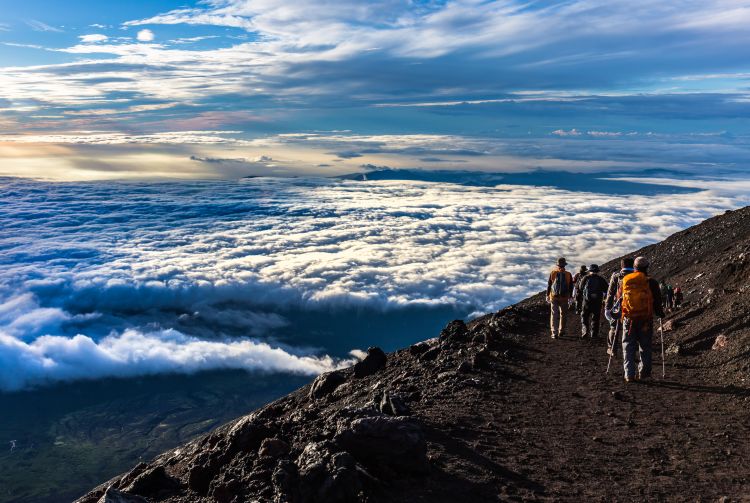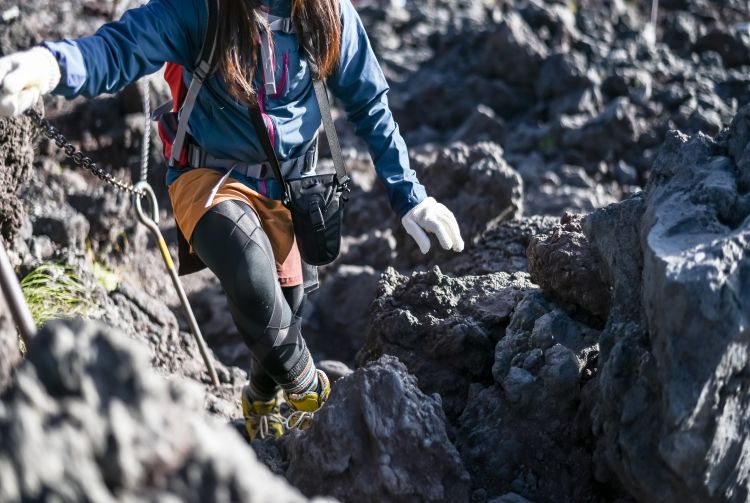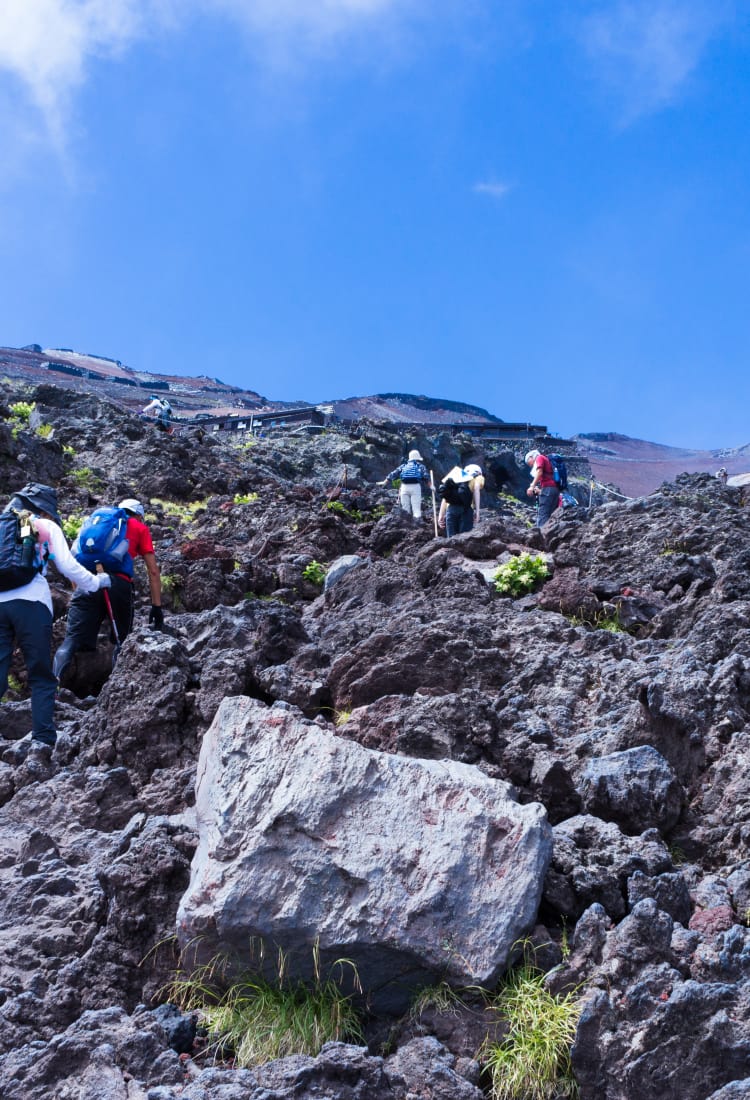How to climb Mt. Fuji, Japan's most famous peak
Towering over Japan at 3,776 meters tall, Mt. Fuji is a worldwide symbol of Japan and a spiritual landmark for its residents. Despite its size, Mt. Fuji is climbed by more than 200,000 hikers every year, including many novices. While you may not have to be a mountaineer to ascend the World Heritage site, you should be in healthy physical condition and properly prepared before your trip.
Don't Miss
- Viewing the sunrise from the summit alongside a few thousand fellow hikers
- Walking along the rim of the summit's crater
- Purchasing a walking stick to get stamped as you climb—an excellent memento
When to climb Mt. Fuji
Mt Fuji opens to hikers from early July to early September, and peak season lasts from late July to late August. Trails are most crowded during the Obon holidays, which usually fall in the middle of August, and can be closed due to rain or wind, so time your ascent carefully.
Many hikers opt for a two-day journey, resting at a hut situated half-way up the mountain before departing for the summit in the early hours of the morning. This plan puts you at the top in time for the picturesque sunrise.
Exercise caution when hiking in the dark as accidents do happen. Novices may wish to hike later in the day when it is safer, warmer and there are fewer crowds.

Mt. Fuji weather
The weather can change drastically along the trail, and thunderstorms are common in the mid-afternoon. Even in mid-summer, the temperature at the summit is between about five and eight degrees Celsius. Layers and warm clothing are essential.

Safety and planning
Hiking in the dark requires extra precaution. Careful planning, adequate gear, and mental preparation are key to climbing the mountain safely. If staying a night on the mountain, make sure to reserve your hut well in advance, as lodgings fill up during the busy season.
Be aware that at higher altitudes the air has a lower amount of oxygen, making you susceptible to lightheadedness and exhaustion. Staying a night will allow your body to acclimatize to the high elevation. Altitude sickness is common on Mt. Fuji, so do your research about how to prevent it. Make sure you know your limits and understand when to turn back down the mountain if you feel sick. It is especially important to pace yourself, stay hydrated, and have enough food with you to last the trip.
What to bring
Equip yourself with proper hiking shoes, a hat, gloves, rainwear, a jacket, quick-drying underwear, a headlamp, trash bags, a walking stick, food, and spending money. Plan on drinking at least two liters of water.
On-site facilities
Mountain huts along the trail are well-equipped with water and other provisions like hiking sticks and snacks. If you are staying the night at one of these huts, note that there is no running water, and the restrooms are not connected to plumbing. Despite the elevation and lack of basic amenities, you'll find the Fuji Summit Post Office at the top of Mt. Fuji, where you can send postcards authentically postmarked from the mountain's summit.
Mt. Fuji trails
Mt. Fuji can be climbed on one of four trails, the most popular being the Yoshida Trail on the Yamanashi Prefecture side. The mountain is divided into 10 “stations,” and each trail begins from its respective 5th station.

Choosing a course: the Yoshida Trail
The Yoshida Trail on the Yamanashi Prefecture side of the mountain is the most popular and accessible of the Fuji hiking trails, with direct buses servicing the trailhead from Tokyo. As such, this trail boasts the largest number of mountain huts and amenities. Budget six hours for the ascent, and four hours for the descent, which takes a separate path. This trail is commonly used to watch the magnificent sunrise at the summit. As a result, it is often hiked in two parts, with an overnight stay at the 7th or 8th station.
Since the Yoshida trail is the most popular, it can get extremely crowded during peak season, particularly on weekends and holidays. The crowds can make it difficult to hike at your own pace.
Choosing a course: the Fujinomiya Trail
The Fujinomiya Trail is shorter than the Yoshida Trail , but steeper and more rigorous. There is no separate descent trail, so you'll have to double back down on the return. The ascent takes around four and a half hours, while the descent takes around two hours.
Choosing a course: other trails
The Subashiri Trail on the eastern side of the mountain offers a less crowded path, but with fewer mountain huts and amenities. It merges with the Yoshida Trail near the Original 8th Station. The Gotemba Trail is the longest route with a duration of seven or more hours as it starts several hundred meters lower in elevation than the others. Note that this trail only has a few mountain huts near the 7th and 8th stations.
Ohachi-meguri Trail (Summit Crater Loop)
Experienced hikers may enjoy adding an extra leg to their hike by going around Mt. Fuji's crater. The hike takes around 90 minutes and is a great way to get a 360-degree view across Japan.
Local accommodations
There are numerous accommodations near Lake Kawaguchiko , easily accessible by bus from the fifth station of the Yoshida Trail . If your schedule permits, consider spending time around the lake and the surrounding Fuji Five Lakes area , which is known for its idyllic natural views and relaxing hot springs. Bathing in one of these onsen is a great way to soothe your legs after a tiring hike.
Those looking for a quick return to the city can forgo extra accommodations and opt for a bullet train or bus ride back to Tokyo.
How to get there
While there are multiple ways to access Mt. Fuji, the most convenient method for hikers traveling from Tokyo is the direct bus service from Shinjuku Station to the 5th station of the Yoshida Trail . The trip takes around two and a half hours. Note that this bus service is only available during hiking season.
If you plan to spend time in the region before your hike, bullet trains serve numerous Shizuoka destinations from Tokyo, Osaka, Nagoya and Kyoto. Shin-Fuji Station is a key transport hub for Mt. Fuji hikes on the Shizuoka side.
For Yamanashi Prefecture , access is on the Chuo Line connecting Tokyo and Matsumoto, in Nagano Prefecture . Kawaguchiko Station is the main port of call for hikers and requires a change at Otsuki Station on the Chuo Line.
Mt. Fuji package tours
For novice hikers or those who don't want to do so much planning, consider climbing Mt. Fuji with a travel company. These tours can arrange pickup in Tokyo, bus tickets, guides, meals, hut reservations, and more. If you want to ensure the most strenuous part of the Mt. Fuji experience is the ascent itself, leave the rest to the experts.






















































